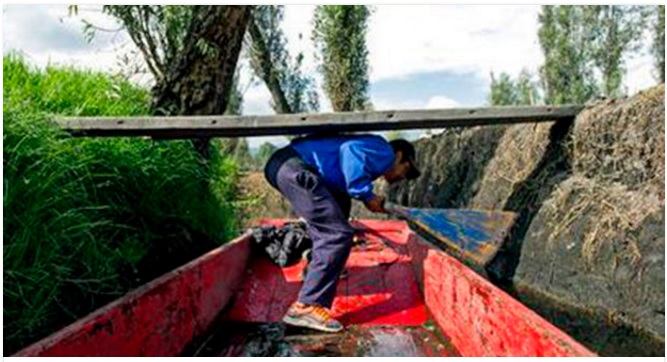Edgar Serralde Galicia lives in a part of Mexico City known for water: Xochimilco, where picturesque canals have irrigated produce grown on man-made islands and served as transportation routes since the days of the Aztecs.
But like roughly a million residents of the capital, Serralde isn’t connected to the city’s water system. While most rely on the water trucks that rumble through the city’s less-affluent neighborhoods, he tried his hand at collecting rainwater and storing it in rusty barrels. When it did not rain, his family had to go to his parents’ house to wash.
“When there’s no water, I feel useless because I feel that I can’t move my family forward,” said Serralde, a lettuce farmer who lives with his wife and their two children. “The truth is we suffered a lot because we are a humble family.”
All that changed when he installed a more-advanced rainwater harvesting system that can store six times more water than his barrels. He says such rain-harvesting systems could be a life-changing solution in a rain-heavy megalopolis that is plagued by water shortages.

In this Aug. 19, 2016 photo, Edgar Serralde ducks below a wooden plank as he navigates through a Xochimilco canal, in Mexico City. Serralde, a rain harvester, uses the rain water he catches instead of relying on the water trucks that rumble through so many of Mexico City’s working class neighborhoods. (AP Photo/Nick Wagner)
Serralde began his attempt at collecting water when he had his one-bedroom house built with a slanted roof, hoping to take advantage of the average of 47 inches of rain that falls on Xochimilco each year, a Venice-like district of canals that draws tourists who are rowed in boats called trajineras.
Then with the help of a Mexican nonprofit group, Isla Urbana, Serralde was able to capitalize on the odd construction of his roof to collect and store far more rainwater than he ever imagined. His new system collects, filters and stores water in a 5,000-liter cistern. For those without a pre-slanted roof, Isla Urbana says the rain collector can be installed either on part or all of a roof. The water passes through two filters, has the sediment removed and emerges safe to drink.
Serralde paid less than 20 percent of the system’s total cost, with the nonprofit covering the majority through government funds and private donations. Without the assistance, he likely would not have been able to come up with the $900 needed to install the system.
Isla Urbana put in its first system in 2009, and since then has installed over 2,600 in Mexico. In one year, over 15,000 gallons of rainwater can be captured by one system alone when installed on a roof measuring 80 square meters (861 square feet).
Click here for full article



